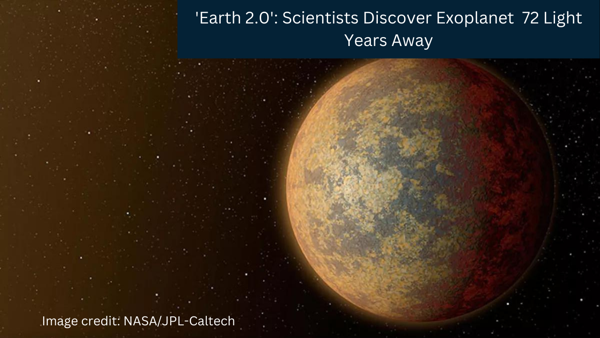
Science & Space
Exoplanet Alert: Discovery An Earth-Sized Exoplanet Has Been Found 72 Light-Years Away
There are trillions and zillions of exoplanets in the universe, and we are watching the universe with the help of ground-based and space telescopes to explore those amazing worlds in the hopes of one day finding the same sphere as our Earth and trying to find the answer to one question: how did the universe and the world form?
There are 5,307 confirmed exoplanets in 3,910 planetary systems as of February 1, 2023, with 853 systems having more than one planet. The majority of exoplanets were discovered by NASA's Kepler space telescope, which was decommissioned on October 30, 2018. NASA is now employing the Transiting Exoplanet Survey Satellite, Hubble, and James Webb in this recent scenario.
Recently, an international team of researchers discovered an exoplanet 72 light years away from our solar system. named K2-415b. The exoplanet was primarily discovered and detected in data from NASA's now-defunct Kepler space telescope in 2017, now, scientists have been able to determine the exoplanet's architecture using the TESS in 2023.
The earth-sized planet K-415b orbits K-415, an M-dwarf star that is much cooler and smaller than the sun.
In fact, K2-415, a red dwarf, is unique because it is one of the coolest and lowest-mass stars known to researchers. Other than K2-415, only four cooler red dwarfs are known to host at least one exoplanet. TRAPPIST-1 is a good example of a cooler star, with seven known exoplanets, the majority of which are in the habitable zone.
K2-415's surface temperature is about 3,173.15K (5,250°F or 2,900°F), in comparison to our sun's 5,753.15K (9,900°F or 5,480°C). The K-415 has a diameter of 0.2 times the sun, or 20% of the sun, and a mass of 0.16 times the sun, or 16% of the sun. Here the difference between the sun and the K2-415 is clearly visible.
The K2-415b is an earth-size exoplanet because its radius is 1.015 times of earth, which is equivalent to 0.09055 times Jupiter's radius. The exoplanet, however, is extremely heavy, three times the mass of the Earth or 0.009 times Jupiter's mass, which explains why its density is 15.8137 g/m3, or 287% of the Earth.
The exoplanet, K2-415b, is extremely close to its star, K2-415, which is why its surface temperature is 400K or 127°C or 338°F, which is not conducive for the life like earth. Its distance from its star is only 0.0270 AU or 2543163.8 km or 2509806.8 miles. It takes only 4.017969 days to complete one revolution around its star, maintaining an inclination of 89.32 degrees.
The star was discovered using the primary transit method, and the radius was discovered using the same method, but the mass of the star was discovered using radial velocity. The K2-415b has been given an alternative name, TOI-5557b.
But, one question remains
If the possibility of life on those exoplanets is very low, why are we exploring those lifeless worlds?
There are two main reasons why researchers and astronomers are looking for these worlds. The first reason is there is a tremendous possibility of finding another exoplanet in such solar systems where earth size planets already exist and the researchers just want to explore those worlds to know the second reason and the second reason is how the planets are being formed and how planets take shape when planets are in a conducive environment to gives birth to different kinds of lives.

0 Comments